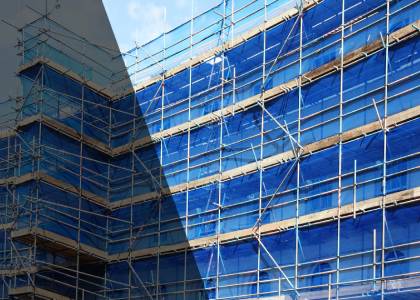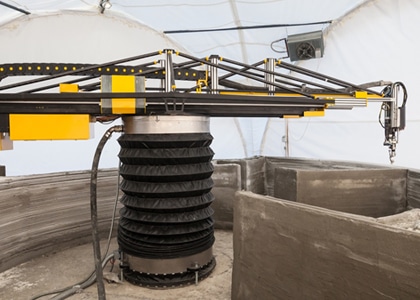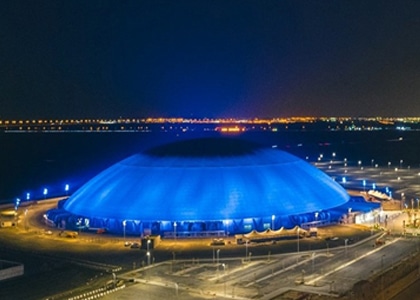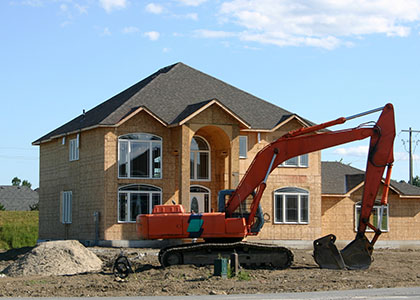Home / Blog / Is it time for saudi arabia to embrace green construction?
SUMMARY
Green construction is gaining traction in the Middle East and beyond, not only due to rising concerns about environmental issues, but also due to the necessity of using resources efficiently. What’s more, the Covid-19 pandemic has changed the landscape of the regional construction industry. Multiple projects were put on hold, and both construction businesses, as well as project timelines and budgets, suffered as a result.
As construction companies now make a full return to work, they are prioritizing the timely completion of existing projects while bidding for new tenders. To make themselves stand out from the competition, they are positioning themselves as sustainable players with a forward-thinking approach that meets the Kingdom’s Vision 2030 plans.
This is because, when it comes to choosing construction companies and assigning projects, businesses consider overhead costs from material wastage and environmental impact. As end consumers and occupiers become savvier and more informed, construction projects that have high a carbon footprint also face negative public opinion and backlash.
This report aims to explore the impact of green construction on the Kingdom’s construction sector, how it can boost the sector’s transformation under Vision 2030, and whether now is the right time for you to adopt this approach.
INDEX
- The current state of the construction industry
- Meet Saudi’s environmental, social, and governance agenda
- Planning recovery in 2021 and laying the foundations for future work
- Sustainable development under Saudi Vision 2030
- The Kingdom’s sustainability-centric megaprojects
IS IT TIME FOR SAUDI ARABIA TO EMBRACE GREEN CONSTRUCTION?
Green construction is not just a buzzword. It has become a necessity in today’s world, where soaring populations and limited resources are raising the stakes for cities with huge carbon footprints. As the Saudi construction industry recovers from the disruptions caused by the Covid-19 pandemic, sustainable construction is expected to play a pivotal role in galvanizing both local and international investments.
What’s more, as the sector maps a route to recovery, Saudi’s construction output is expected to increase by 3.3% this year. Embracing green construction that takes an environmentally friendly and resource-efficient approach at every stage of a project’s life cycle can help the industry and its players make a more positive mark.
The Kingdom is already leading in the region in meeting its many sustainability targets, but it has its eyes set on even bigger goals. By designing and building future-oriented, green cities and structures, Saudi hopes to position itself as a global player focusing on three main points: the planet, the people, and profits. Getting aboard the projects that focus on sustainability and leveraging cutting-edge innovations can benefit your construction company by giving you more visibility and coverage. They can also help you reduce costs and meet your timelines.
Here’s how green construction can help your business grow.
- Current state of the construction industry
While the MENA construction industry faced contraction in 2020 due to the Covid-19 pandemic, things are looking good for this year. According to a study by GlobalData, the MENA region’s construction output is expected to grow by 1.9% in 2021, and 4.1% next year. The same study also forecasts a positive output for Saudi. The Kingdom’s construction is predicted to move into recovery mode, putting it on a trajectory for increased economic performance in the coming years. However, as businesses mitigate future fallouts, they will be more focused on cost-efficiency and on cutting down on wastage of construction materials.
- Heavy carbon footprint
The global construction industry has a significant carbon footprint. It is estimated that around 38% of the global energy-related carbon emissions come from this sector. Combined with the Gulf region’s already high ecological footprint, more needs to be done to make the sector environmentally conscious. Saudi, along with other regional countries, needs to improve its infrastructure further to boost sustainability. While the global average for recycling, recovering or reusing plastic and metal waste is at around 32%, in the GCC region, these efforts tally in at an estimated 10%. With the government increasingly focusing on reducing Saudi’s carbon footprint across all sectors of the economy, one of the ways construction companies are addressing this is by increasing recycling collection of construction waste by including the transport sector.

- Saudi’s environmental, social, and governance agenda
Under the leadership of Prince Mohammad bin Salman, Saudi is establishing itself as a global player on all fronts. This means putting environmental and social governance (ESG) on the agenda in a big way.
ESG is an integral part of sustainable construction. As construction work on the Vision 2030 mega projects propels the sector back into action, businesses that are looking to get a bigger piece of the pie must start using environmentally friendly construction materials efficiently. They need to consider environmental impacts, energy consumption and be seen as organizations that reduce carbon footprints and are resource efficient.
This is exactly what construction companies at megaprojects sites like the AMAALA, NEOM, and Qiddiya are doing. They are catering to a new generation of future residents who put personal well-being and net-zero carbon emissions high on their priority list.
- Planning recovery in 2021 and laying the foundations for future work
The Covid-19 pandemic brought disruptions to global supply chains where construction companies had to work with limited resources and labor. Housing demands and workplace requirements also changed due to health concerns, lockdowns, and social distancing rules. This pushed the construction sector to look for new, innovative approaches that were cost-efficient and durable.
Sustainable construction can be the cornerstone of the sector’s recovery post-pandemic. The global market for green construction is projected to reach USD 364.6 billion by 2022. Not only is the demand for low-impact building expected to grow over the next 25 years, but construction firms that are planning their future moves now, are projected to do better than traditional competitors. As the sector bounces back, it is likely that there will be fewer projects, and costs and environmentally friendly approaches will be key considerations when tenders are awarded.
You may also want to consider green construction as a future building approach as studies indicate that:
- Green buildings are rented and sold at a higher price point
- They drive more commercial interest in the form of financing
- When completed, green buildings reduce construction costs
- Green buildings also operate at lower maintenance costs and save on resources like energy and water
Additionally, as a business case, green construction also comes with the following positives for your company:

- Reduced design and construction costs
As building codes around the world, Saudi included, become stricter, construction companies like yours are finding added benefits to going green. Global supply chains for green materials are also maturing and sourcing supplies is becoming easier to help organizations build in more ecologically friendly ways at reduced costs.
- Asset value
As both investors in construction projects and end occupiers become more knowledgeable and concerned with the environmental and social impacts of building work, buildings with better sustainability credentials have increased marketability. In more developed markets, construction companies are finding that green building methodologies attract more tenants and help command higher rents and sale prices.

- Reduced operating costs
Green buildings have been shown to save money through reduced energy and water consumption and lower long-term operations and maintenance costs. The energy savings alone typically exceed any cost premiums associated with their design and construction.
- Workplace productivity and health
Post-pandemic there has also been an increase in focus on worker safety and the environment. Emerging evidence suggests that green construction materials are not only safer to work with, but that the physical characteristics of buildings and indoor environments can influence worker productivity, occupant health, and well-being.
As Saudi leverages new and innovative technologies to achieve its sustainability goals, green building materials can help construction businesses align with governmental projects. The Kingdom is accelerating the production of high-quality houses for residents and establishing human-centric sustainable cities with net-zero carbon emissions to meet the country’s energy needs. By building “green” you can get more visibility so that you can better deliver on large-scale governmental economic priorities, such as climate change mitigation, energy security, resource conservation, job creation, long-term resilience, and quality of life.

- Sustainable development under Saudi Vision 2030
The Kingdom’s housing program under Vision 2030 aims to boost the production of high-quality houses and make them available to Saudi families at affordable prices. By 2030, around 70% of families in the country are expected to own houses. What’s more, human-centric, environmentally friendly megaprojects and smart cities like NEOM and the Red Sea Project are pushing sustainable living to new heights. The country’s economy is also being diversified under Vision 2030, which will surely contribute to increasing sustainability.
Incorporating new technologies and materials to meet a Vision 2030 mandate
Green building technologies are becoming the hottest new trend in an industry that is ripe for some disruption! The benefit of some of the following applications can be far-reaching and comprehensive, offering significant advantages for construction operators like you:
- 3D printing
Recently, 3D construction printing (3DCP) technology has been introduced in Saudi. It holds huge potential in cutting down the cost of buildings by half and significantly reducing construction time. For example, 3DCP houses can be constructed in a day and can also significantly reduce labor costs and construction waste.
- Cross-laminated timber
Many construction companies in the Kingdom have started using cross-laminated timber (CLT) instead of steel and concrete to reduce the industry’s carbon footprint.
- Green concrete
Replacing cement for green concrete can also help reduce wastage of construction materials by around 20%.
- Solar power
Using solar power—both actively and passively—can help save on energy during construction and after.
- Biodegradable construction materials
Traditional construction methods accumulate waste products and toxic chemicals that take a long time to degrade and are harmful to the environment. Biodegradable materials such as organic paints, limit impact easily decomposing without the release of toxins. The use of biodegradable materials for building foundations, walls, and insulators are also more sustainable ways to build.

- The Kingdom’s sustainability-centric megaprojects
The Kingdom has rolled out over 300 green building projects. These make up around 15% of all green building projects in the Middle East.
It is important to keep in mind that sustainability covers every aspect of a building project’s life cycle—be it planning and design or energy consumption. It even focuses on the building’s demolition because at that stage it’s necessary to make sure that the residual parts are reusable or can be recycled.
One example of the Kingdom’s energy-efficient buildings includes the new construction design for the Ministry of Environment Water and Agriculture (MEWA) in Riyadh. The building includes a solar system capable of meeting 75% of the complex’s energy needs. In addition, the new Red Sea International Airport will have multiple pods, one or more of which can be shut down to save energy. Similarly, the King Abdullah Petroleum Studies and Research Center (KAPSARC) has been dubbed the “smartest building” in the Kingdom and has won multiple awards for its sustainability features. Around 30% of its honeycomb structure has been made with recycled materials. It can deflect sunlight and capture natural winds for ventilation.
- Key Saudi projects that incorporate sustainability
Under Vision 2030, the Kingdom has launched a number of megaprojects that aim to improve the quality of life for all residents while minimizing the country’s carbon footprint. To achieve all this, the Kingdom has employed smart infrastructure and innovative technologies. Here are just a few of the sustainability-centric megaprojects that are driving a new wave of environmentally conscious construction design and methods:
- SPARK
King Salman Energy Park (SPARK) is a megaproject that covers around 50 square kilometers between Al-Ahsa and Dammam. Sustainable and innovative construction technologies are being used in its development to ensure that wastage of construction materials, carbon emissions, and effects on the environment remain minimal. One of these solutions is the cutting-edge Podzolic green concrete. Made with recycled materials, green concrete is much more environmentally friendly.
Not only is SPARK the world’s first industrial city that received a LEED Silver Certification, but it is also the first project in the Kingdom to employ Podzolic green concrete and ConXtech steel connection technology, which improve efficiency and safety.
Another first is the use of Glass Fiber Reinforced Polymer (GFRP). It is a non-metallic material that can be used instead of epoxy steel reinforcements. Besides being lighter than steel, it is also stronger and does not corrode.
- Red Sea Project
The Red Sea Project will focus on promoting tourism while ensuring sustainable development. It aims to give tourists a chance to explore over 90 islands as well as the Kingdom’s beaches, mountains, desert landscapes, and even volcanic areas. Besides natural beauty, tourists will also be able to learn about the Kingdom’s culture. Developed by the Red Sea Development Company (TRSDC), the project also includes the construction of an airport, marina, recreational facilities, and 8000 hotel rooms. The luxury tourism destination is expected to create around 70,000 new jobs and attract almost a million visitors annually. In terms of sustainability, the environment covered by the Red Sea Project will be protected and preserved. In fact, it will be maintained at the same level as a Marine Protected Area. Carbon emissions and noise and light pollution will be kept at a minimum. Only renewable energy will be used for the project. Its development is being aligned with the UN’s Sustainable Development Goals (SDGs) as well as the Saudi Vision 2030.
- NEOM and the LINE
NEOM is being launched by the Kingdom as a planned smart city to promote sustainable living. Situated in the Tabuk Province, NEOM will be loaded with innovative technologies and serve as a tourism, research, and business hub. The entire smart city will run on 100% renewable energy. Since it will be a human-centric city, pedestrians will be able to walk to any amenity within five minutes.
THE LINE, a 170km long city will be established within NEOM. There will be no carbon emissions, streets, or even cars in this city. All transportation will take place below the surface. This approach allows the city, which can accommodate around a million people, to eliminate traffic congestion and pollution. THE LINE focuses on human health and well-being and will make life easier with invisible AI-based systems. It will be developed in line with the circular carbon economy (CCE) and is expected to create 380,000 new jobs.
With several sustainability-centric megaprojects and hundreds of green buildings already rolled out, the Kingdom is no stranger to green construction. Since the country’s construction output is expected to increase significantly this year and one of the goals under Vision 2030 is to provide more high-quality houses to residents, the process can be accelerated by investing in more infrastructure and innovative technologies and putting an even greater focus on green construction.
To find out about new green construction design and technologies, get in touch with us here.












